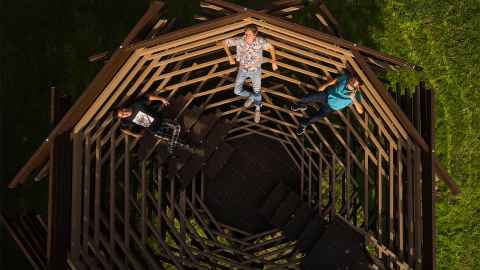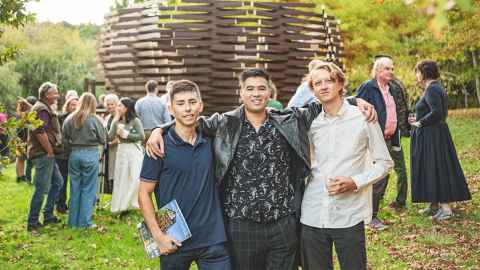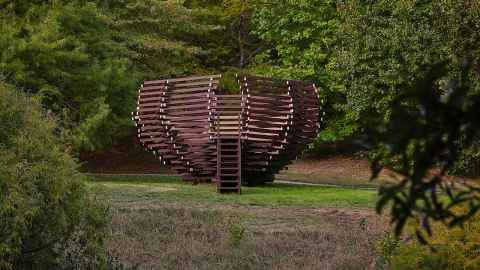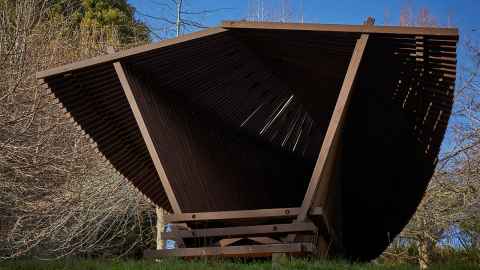Architecture students nest on their laurels
1 June 2022
The student creators of winning sculpture The Nest salvaged a previous winning sculpture, also by University of Auckland students, to give it new life.

Sustainability is the name of the architectural game and that also applies to sculpture.
And so, three Master of Architecture students used an upcycling approach to build the award-winning structure that took first place in the recent Brick Bay Folly competition.
The competition started in 2016, open to architecture students and recent graduates to design and build a folly at Brick Bay in Matakana. It provides the chance for emerging architects to test their ideas on a real-life project, manage construction, solve contingencies and participate in physical construction. A folly is an experimental structure without specific purpose or restrictions, therefore it can be whimsical, humorous, decorative or boundary-pushing.
The students – Nicholas Rowsby, Brandon Carter-Chan and Joseph Trace – created their winning structure The Nest in 2021, in the final year of their masters at Auckland. They repurposed wood used in a previous Folly-winning work,The Wood Pavilion, built by four architecture masters students in 2019.
Being created entirely out of the recycled timber, The Nest showcases how architecture can rise to some of challenges of our times – such as how to create without waste, and how to design for, and work with, wood amid a timber shortage.
Folly judge and one of the event’s sponsors Pip Cheshire (Cheshire Architects) says the creative process has evolved over time to more closely consider sustainability and reuse.
“What you’re seeing here is a really interesting evolutionary view that materials are scarce resources.
“This idea of reuse, and circular use of the timber that is milled and then made into something, then dissembled and made into something else again, is a really exciting development in how timber is used.”

This idea of reuse, and circular use of the timber that is milled and then made into something, then dissembled and made into something else again, is a really exciting development in how timber is used.
Nicholas says the idea for The Nest came from a site visit to Brick Bay Winery in June 2021, home to the well-known Sculpture Trail. “We didn’t want to see the material of The Wood Pavilion discarded,” he says.
“We were also inspired by the abundance of pīwakawaka on the site; it led us to approach the design the same way a bird would build its nest from the resources in its immediate surroundings – what I think of as nature’s most contextual architecture.”
The sculpture is also a nod to its surroundings at Brick Bay Winery and references the delicate stacking and weaving of twigs.
“There’s the practice of collecting grapes in a basket woven from their vines … it inspired us to invoke the bowl-like form of a bird’s nest.”
Having been in the same university year group as the designers of The Wood Pavilion, they approached them for its dimensions.
“Much of the design phase took account of the component dimensions in The Wood Pavilion, with many of the pieces staying the same size in the structural scheme of The Nest,” says Joseph.

It is still very possible to achieve beautiful architecture from reused building materials without costing an arm and a leg.
The challenge came in trying to maintain each piece of timber in their full lengths while also allowing for the weathering of timber exposed to the elements over two years. There was also the potential damage that could be incurred in the process of dismantling it, so the team devised a method of deconstruction that would cause minimal damage, using a pulley system.
“We carried the segments to another section of the site to carefully dismantle it. This involved every screw being unscrewed mostly by hand with vice grips or an Allen key and metal rod. Some sections we even needed crowbars or couldn’t physically pull apart as the 2019 team had fixed them together so well.”
They were able to salvage around 797 linear metres of timber and used 746 metres of it for The Nest. Timber too damaged to use was cut down and repurposed for smaller elements such as seating or stairs.
“There were many large bolt, screw and nail holes as well as crowbar denting left in the reclaimed timber which comprises The Nest,” says Nicholas. “At one stage we contemplated trying to minimise traces of reuse, but in the end, we realised that these imperfections capture the history of the material and are desirable visual and tactile qualities in their own right.”

There were other challenges; the deconstruction of The Wood Pavilion took place in October 2021, during lockdown and under strict Covid rules, with no access to workshops and limited access to supplies.
The project demonstrates that the recycling and repurposing of wood does not mean compromising beauty, adds Brandon.
“It is still very possible to achieve beautiful architecture from reused building materials without costing an arm and a leg. We managed to achieve this build with the restrictions of Covid and a full-time masters thesis. We can do so much with timber, and we encourage everyone to keep thinking of new, sustainable solutions.”
The Nest will stay on display at Brick Bay for two years. It is a part of the sculpture trail showcasing more than 60 sculptures.
By Margo White and Denise Montgomery
This story appeared in the June 2022 edition of UniNews.